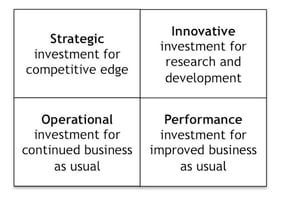A Bagged Mix
A number of ‘authorities’ assert that you need a balanced portfolio and therefore need to “manage the mix of projects in your portfolio”. You need to have some strategic, operational, performance and innovative investments, for example. But is this valid?
An example of a typical Portfolio Mix matrix.

Attaining this ‘mix’ is positioned as part of ensuring you have a ‘balanced’ portfolio. “If you don’t have a mix of projects your portfolio is unbalanced,” they say.
The concept appears to have been derived from the Boston Box of product lifecycles – where you have ‘Stars’, ‘Cash cows’ and ‘Dogs’. This Box was designed (in the 1970s) to help organizations know where they are investing and why.
Strategic portfolio management
But a project portfolio is not a product lifecycle. It is a strategic investment portfolio. Your project portfolio needs to be driven by the needs of your strategy not by some arbitrary matrix criteria.
True, if all your investments are short term and highly tactical, and you ignore longer-term strategic needs, your business will suffer down the track. This can be useful to know and should come from an analysis of your portfolio’s planned strategic contribution (ie an analysis of which strategies the portfolio’s projects are delivering or are not delivering) rather than as some arbitrary classification of project types.
Your portfolio should always be determined by your strategy (that itself may be short-term). Having worked in an organization that was suddenly facing immediate death, long-term strategic ambitions were a bit irrelevant. It was “What do we need to do NOW to mitigate the situation and survive?” This may be an extreme example but it does illustrate that the portfolio needs to reflect the imperatives of the organization’s strategy not some “balanced portfolio matrix”.
Strategic prioritization
The first prioritization question (after, “Is it mandatory?”[1]) should always be, “How and how much does this proposed project contribute to our strategy?” This contribution should be measured by assessing each project’s planned contribution to each of the 30-to-40 ‘strategic imperatives’ that need to be actioned for your strategy to be delivered. Operational needs also need to justify their level of strategic relevance and contribution the same way.
The second prioritization question is “How much (net) value will this project contribute?” and the remaining questions assess deliverability.
So your portfolio ‘mix’ should be made up of:
- Mandatory projects (at minimum cost)
- Strategically relevant projects which are also viable and deliverable.
What other types of projects do you need? Should you really look at your ‘mix’ criteria and add in ‘missing’ project types even if they are not strategically relevant, viable or deliverable? Obviously not.
False fitting to a model
This ‘fit the model’ type of thinking reminds me of a CEO that was very ratios-driven and believed that 2.5% of sales revenue should be invested in advertising. When his firm’s sales were doing exceptionally well one year he rang the head of sales to complain that the advertising spend was less than 2.5% and, therefore, he should spend more to meet the sales-to-advertising ratio. Why spend unnecessarily just to make a ratio?
The same applies to the concept of ‘portfolio mix’. This is a misconceived notion (product lifecycle thinking does not apply here) that tries to substitute some spurious classification formula for an effective strategic contribution measurement, prioritization and selection process.
To illustrate the futility of trying to categorize projects into a portfolio matrix – think of an ERP system—is its implementation: strategic, operational or performance enhancing – or all three? Does trying to categorize it into one box actually move you forward and help you execute your strategy, improve the business and deliver more value? More likely any categorization is a waste of time.
What to do
Don’t waste time pursuing ‘portfolio mixes’ – instead invest that time in measuring in detail each project’s strategic contribution and then tracking the successful execution of your strategy.
It really is that simple.
To prioritize effectively you need an effective Strategy Contribution Assessment Tool—which most organizations do not have. Having a "SAT" is essential to your success.
[1] Projects are only ‘Mandatory’ if they are required by legal or regulatory changes



